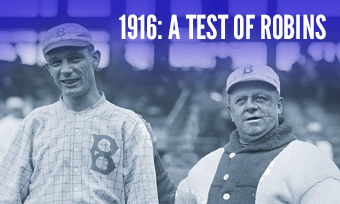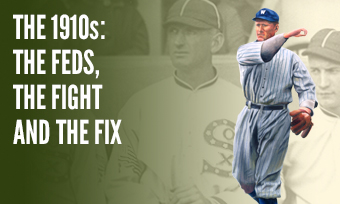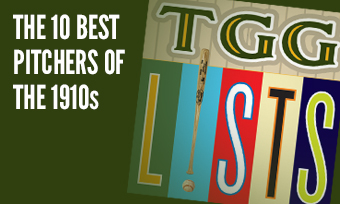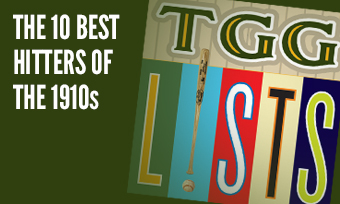The Yearly Reader
Leaders and Honors, 1916
Our list of baseball’s top 10 hitters and pitchers in both the American League and National League for the 1916 baseball season, as well as the awards and honors given to the game’s top achievers of the year.
The National League’s Top 10 Hitters, 1916
Bold type in brick red indicates league leader.
1. Hal Chase, Cincinnati
Key Numbers: .339 average, 184 hits, 29 doubles, 12 triples, 82 RBIs.
The bookies must have been in hiding; Chase played on the up-and-up enough to win his only batting title.
2. Zack Wheat, Brooklyn
Key Numbers: .312 average, 76 runs, 177 hits, 32 doubles, 13 triples, 9 home runs, 73 RBIs, .461 slugging percentage.
Baseball’s anti-Ty Cobb—the quiet, cordial Wheat—let his bat do all the angry talking.
3. Gavvy Cravath, Philadelphia
Key Numbers: .283 average, 21 doubles, 8 triples, 11 home runs, 70 RBIs, 64 walks, 89 strikeouts, .379 on-base percentage.
After a summertime slump, Cravath hit six of his 11 homers in September and became the first major leaguer in the Deadball Era to reach double figures in each of five straight seasons.
4. Bill Hinchman, Pittsburgh
Key Numbers: .315 average, 175 hits, 16 triples, 76 RBIs, 8 intentional walks, 17 grounded into double plays.
The late-blossoming talent peaked before a sudden fadeout in 1917; he would stick around with the Pirates for another 39 years as a scout, starting in 1921.
5. Dave Robertson, New York
Key Numbers: .307 average, 88 runs, 180 hits, 12 home runs, 69 RBIs.
Robertson needed a full season to match Cy Williams in the NL home run count; he’d tie for the league lead again the following year, this time with Gavvy Cravath.
6. Benny Kauff, New York
Key Numbers: .264 average, 22 doubles, 15 triples, 9 home runs, 74 RBIs, 68 walks, 40 stolen bases.
The highly-anticipated Giants debut for Kauff after his superstar turn in the Federal League didn’t blossom out as equally in the NL, but he was still a force to be reckoned with.
7. Max Carey, Pittsburgh
Key Numbers: 118 games, .279 average, 9 triples, 12 home runs, 66 RBIs.
The speedster’s batting average continued to stall, but he more than made up for it when he managed to reach base.
8. Cy Williams, Chicago
Key Numbers: 160 games, .307 average, 179 hits, 31 doubles, 16 triples, 85 RBIs.
Despite missing nearly 40 games, Williams still led the NL in home runs—hitting eight of his jacks during the Cubs’ first year at Wrigley Field.
9. Rogers Hornsby, St. Louis
Key Numbers: .313 average, 17 doubles, 15 triples, 6 home runs.
After an underachieving debut in 1915, the Cardinals told Hornsby to bulk up or bail out; he eagerly took the first bit of advice.
10. George Burns, New York
Key Numbers: .279 average, 623 at-bats, 105 runs, 24 doubles, 8 triples, 37 stolen bases.
A bounceback year for Burns despite hitting just .223 at the Polo Grounds and .331 everywhere else.
The American League’s Top 10 Hitters, 1916
1. Ty Cobb, Detroit
Key Numbers: .371 average, 113 runs, 201 hits, 31 doubles, 10 triples, 78 walks, 68 stolen bases.
Despite being dogged by influenza, Cobb remained the AL’s premier offensive threat.
2. Tris Speaker, Cleveland
Key Numbers: .386 average, 102 runs, 211 hits, 41 doubles, 8 triples, 79 RBIs, 82 walks, 35 stolen bases, .470 on-base percentage, .502 slugging percentage.
With something to prove after the Red Sox lowballed him on salary, Speaker became the AL’s first official batting champion other than Ty Cobb in six years.
3. Joe Jackson, Chicago
Key Numbers: .341 average, 91 runs, 202 hits, 40 doubles, 21 triples, 78 RBIs.
In his first June spent in a White Sox uniform, Joe Jackson hit .512 (44 hits in 86 at-bats).
4. Bobby Veach, Detroit
Key Numbers: .306 average, 92 runs, 173 hits, 33 doubles, 15 triples, 91 RBIs.
As age was finally catching up to Sam Crawford, Veach took over as Ty Cobb’s star teammate in the outfield.
5. Eddie Collins, Chicago
Key Numbers: .308 average, 87 runs, 17 triples, 86 walks, 40 stolen bases.
Despite more humbling numbers than his White Sox debut the year before, Collins nevertheless became the first Pale Hose hitter to bat over .300 in consecutive seasons since Danny Green from 1902-03.
6. Wally Pipp, New York
Key Numbers: .262 average, 20 doubles, 14 triples, 12 home runs, 93 RBIs, 82 strikeouts.
The second-year Yankee became the first player in franchise history to lead the league in home runs. A certain pitcher in Boston would soon make everyone forget about that.
7. George Sisler, St. Louis
Key Numbers: .305 average, 83 runs, 177 hits, 11 triples, 76 RBIs, 34 stolen bases.
A year after giving it a try as a rookie pitcher, it became obvious that Sisler’s baseball destiny lay at the plate—and he helped give the Browns their first winning record in eight years.
8. Burt Shotton, St. Louis
Key Numbers: .283 average, 614 at-bats, 97 runs, 110 walks, 41 stolen bases, 28 caught stealing.
The future manager’s reign as a leadoff hitter came to a close as he walked over 100 times for the second straight year and stole over 40 for the fourth straight time.
9. Del Pratt, St. Louis
Key Numbers: 158 games, 35 doubles, 12 triples, 5 home runs, 103 RBIs.
The Browns’ iron man led the league in games played for the fourth straight year—and showed off his qualitative abilities by also leading the AL in RBIs.
10. Harry Heilmann, Detroit
Key Numbers: .282 average, 30 doubles, 11 triples, 77 RBIs.
Warming up for the four batting titles that lay ahead of him in the 1920s, the 22-year-old Heilmann established himself as one of three vaunted Detroit outfielders, along with Cobb and Veach; he also won over local fans for saving a woman from drowning in the Detroit River.
The National League’s Top 10 Pitchers, 1916
1. Pete Alexander, Philadelphia
Key Numbers: 1.55 ERA, 33 wins, 12 losses, 45 starts, 38 complete games, 16 shutouts, 389 innings, 167 strikeouts.
Alexander not only shut out every NL team at least once, but also fired nine of his record 16 blankings at home in Baker Bowl, the Coors Field of its day.
2. Dick Rudolph, Boston
Key Numbers: 2.16 ERA, 19 wins, 12 losses, 312 innings.
Voluminous Braves Field continued to be the Boston ace’s best friend; though he won 11 games on the road, his home ERA was a spiffy 1.38.
3. Jeff Pfeffer, Brooklyn
Key Numbers: 1.92 ERA, 25 wins, 11 losses, 30 complete games, 328.2 innings.
Not to be confused with the Big Jeff Pfeffer who 10 years earlier lost 22 for the Braves—this Pfeffer was actually bigger and, in 1916, much, much better than his namesake.
4. Ferdie Schupp, New York
Key Numbers: 0.90 ERA, 9 wins 3 losses, 30 appearances, 11 starts, 140.1 innings.
During the Giants’ record 26-game win streak in September, Schupp started six games and finished them all with four shutouts to help bring his season ERA to 0.90; but it’s not recognized in the record book as the lower ever because he fell 14 innings shy of qualifying under modern rules.
5. Eppa Rixey, Philadelphia
Key Numbers: 1.85 ERA, 22 wins, 10 losses, 287 innings.
After four years of prepping himself for stardom in the majors—he never played minor league ball—Rixey reached his goal with his first of four 20-win seasons.
6. Lefty Tyler, Boston
Key Numbers: 2.02 ERA, 17 wins, 9 losses, 6 shutouts, 249.1 innings.
Tyler finally shed his .500 reputation with a truly winning mark; one of his 17 victories ended the Giants’ 26-game win streak in September.
7. Rube Marquard, Brooklyn
Key Numbers: 1.58 ERA, 13 wins, 6 losses, 5 saves.
Pitching on less gas than during the early, more dominant stage of his career, Marquard rose from the dead (as in a dead arm) and was more effective on the mound than he ever was during his Giants days.
8. Pat Ragan, Boston
Key Numbers: 2.08 ERA, 9 wins, 9 losses.
A midseason funk curtailed Ragan’s win total to almost half of that collected the year before, but he still ended the season with a lower ERA.
9. Al Demaree, Philadelphia
Key Numbers: 2.62 ERA, 19 wins, 14 losses, 39 appearances, 35 starts, 25 complete games, 285 innings.
The former Giant had two shots to win his 20th game—and help give the Phillies the pennant—in the team’s final series against the Braves. The Phillies lost both games.
10. Hippo Vaughn, Chicago
Key Numbers: 2.20 ERA, 17 wins, 15 losses, 44 appearances, 35 starts, 21 complete games, 294 innings, 144 strikeouts.
For the only time within a six-year span, Vaughn failed to win 20 games. It certainly wasn’t due to a lack of trying, as he couldn’t benefit from one of the league’s poorer offenses.
The American League’s Top 10 Pitchers, 1916
1. Babe Ruth, Boston
Key Numbers: 1.75 ERA, 23 wins, 12 losses, 40 starts, 9 shutouts, 323.2 innings, 170 strikeouts.
As he emerged upon the baseball stage as an elite pitcher, Ruth tossed nine shutouts to establish an AL record among lefties that would stand for 62 years. Two of those blankings came in head-to-head competition against Walter Johnson.
2. Walter Johnson, Washington
Key Numbers: 1.90 ERA, 25 wins, 20 losses, 36 complete games, 369.2 innings, 228 strikeouts.
No pitcher threw more innings in a season without allowing a home run than Johnson in 1916.
3. Bob Shawkey, New York
Key Numbers: 2.21 ERA, 24 wins, 14 losses, 8 saves, 53 appearances, 276.2 innings.
One of Connie Mack’s many exiles from Philadelphia, Shawkey set career highs in wins, saves and opponents’ batting average (.209).
4. Harry Coveleski, Detroit
Key Numbers: 1.97 ERA, 21 wins, 11 losses, 324.1 innings.
The 30-year-old southpaw finished his third straight year with at least 20 wins and 300 innings to go with a career-low ERA; the rigors of all that work would catch up to him the following spring as he would win just four more major league games.
5. Reb Russell, Chicago
Key Numbers: 2.42 ERA, 18 wins, 11 losses, 56 appearances, 5 shutouts, 264.1 innings.
Strangely, Russell’s home ERA (3.41) at pitcher-friendly Comiskey Park was far higher than that on the road (1.58).
6. Eddie Cicotte, Chicago
Key Numbers: 1.78 ERA, 44 appearances, 19 starts, 15 wins, 7 losses, .682 win percentage.
Appearing more as a reliever than starter for the only time in his career, Cicotte posted the White Sox’ best ERA; it was a thin 1.26 coming out of the bullpen.
7. Carl Weilman, St. Louis
Key Numbers: 2.15 ERA, 17 wins, 18 losses, 276 innings.
For the second straight year, Weilman’s exceptional ERA couldn’t translate into a winning record.
8. Dutch Leonard, Boston
Key Numbers: 2.36 ERA, 18 wins, 12 losses, 274 innings.
It wasn’t anything like his record-breaking 0.96 ERA performance of two years earlier, but that’s a tall order; Leonard remained among the best of pitchers on a championship team.
9. Red Faber, Chicago
Key Numbers: 2.02 ERA, 17 wins, 9 losses.
White Sox fans were just happy to know that Faber was still alive after Chicago papers ran a September headline blaring “Red Faber Killed in Self-Defense.” Turns out it was a moose White Sox owner Charles Comiskey had named after Faber.
10. Carl Mays, Boston
Key Numbers: 2.39 ERA, 18 wins, 13 losses, 44 appearances, 24 starts, 14 complete games, 245 innings, 8 pickoffs.
In his first full season—half of which was spent coming out of the bullpen—Mays showed off his ability to induce an abundance of ground balls; his assist totals in each year from 1916-18 would be the three highest ever recorded by a Red Sox pitcher.









